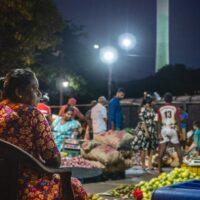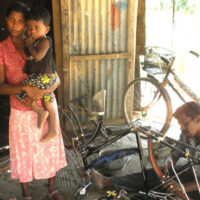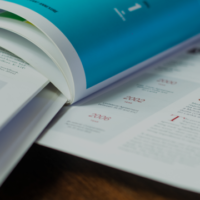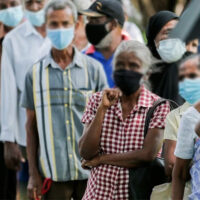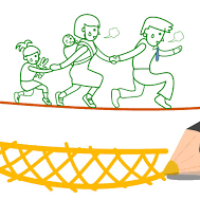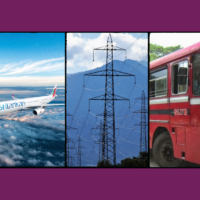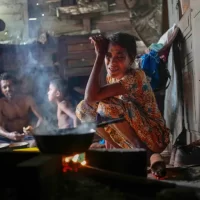Paradox of Persistence of Poverty in Paddy Farming Whilst Achieving National Self-Sufficiency
Hemesiri Kotagama
“A farmer having washed away the grime, is fit to be a king”
Sri Lankan Proverb
Introduction: The social-economic-political significance of paddy farming is obvious to “rice-eating” Sri Lankans. Yet, for formality sake, let’s state that, rice is the staple diet of Sri Lankans, which provides 45% total calorie and 40% total protein requirement for an average Sri Lankan. About 1.8 million farm families (30% of the 5.98 million national households) are engaged in paddy cultivation. Paddy farming occupies 34 percent of the total cultivated area (Senanayake and Premeratne, 2016). Most of the paddy cultivation occurs in rural areas, where 80% of the poor live. In most provinces, poverty among households that are dependent on agriculture is higher than among households not dependent on agriculture (World Bank, 2009). Despite the persistence of poverty among farmers Sri Lanka has achieved self-sufficiency in paddy production (vide Table 1).
Table 1. Rate of paddy self-sufficiency in Sri Lanka

Source: Department of Census and Statistics (http://www.statistics.gov.lk/Agriculture/StaticalInformation/PaddyStatistics/SelfSufficiencyInRice)
Research problem: This article presents an analysis of the degree of poverty and reasons for the persistence of poverty among paddy farmers, despite achieving self-sufficiency in national paddy production. The moral expectation is that paddy farmers who have and are contributing to paddy self-sufficiency and national food security should enjoy a livelihood at least as much as their counter parts, through paddy farming alone.
Analytical method: Degree of poverty is measured, by comparing paddy farm Household (HH) cash income, with the following indicators (sourced from HH Income Expenditure Survey (2019), Department of Census and Statistics).
i. National HH poverty line (Rs. 25774). The official poverty line is Rs. 6966/month/person and the HH size is 3.7.
ii. National average rural HH income per month (Rs. 69517).
iii. National average rural HH expenditure per month (Rs. 57652).
It is hypothesized that the cash income of a paddy farming HH would be more than above indicators, viz; the ratio between cash income of a paddy farming HH and any of above indicators would be more than 1. The ratios are rounded-up to full numbers for convenience of interpretation.
Financial analysis considers only the cash input costs and return components of the enterprise, thus excluding the non-financial components, such as the costs of farmer’s own inputs, the values of government provisions of land, water, extension, subsidized fertilizer. However the value of home consumed paddy is given a value on market price of paddy. Marketed surplus is 91% of harvest (Senanayake and Premaratne, 2016). The financial profitability is considered, as it determines largely, the HH welfare in a market economy. The data on financial profitability is obtained from, Socio Economics and Planning Centre (2019) Department of Agriculture Sri Lanka. Year’s post of 2019 is not considered as those years were outliers due to covid epidemic, the sudden implementation of organic fertilizer application policy and the national economic crisis.
Results: Table 2 (placed at end of article) provides the estimates of financial profitability of paddy farming in several regions. The results of ratio analysis given in table 2 indicates that the hypothesis that paddy farm cash incomes are higher the national HH; poverty line, income and expenditure of rural HH, is rejected. Except in Ampara-East and Mahaweli system B, where the ratio between paddy farm cash income over national HH poverty line is 2, on all other regions the ratios are not more than 1. This indicates that cash income from paddy farms are below the poverty line. In most regions the cash income from paddy farms are just equal or below national rural HH income and expenditure. The paddy farmers may be coping-up to increase their HH income, through means of highland cropping, crop diversification, pluractivity, more than one HH member earning (national average is 1.8 income earners per HH), etc.
The reasons for poverty among paddy farmers could be examined per variables considered in this analysis, such as low paddy yields, low prices, high cost of production and small farm size. Given below in Table 3 and 4 are results of ‘What If’ analysis on what ought to be the land size and paddy yield that would equate paddy cash income to above mentioned national HH; poverty, rural income and rural expenditures. The analysis is based on Polonnaruwa region data, as it has the highest paddy yield.
Table 3. Estimates of land size to achieve national HH poverty line, rural income and expenditure

The results of table 3 indicate that, farm size should double in order to earn a cash income from paddy equivalent to average rural HH income and expenditure. Is it feasible to increase the farm size? The World Bank (2009) recommends as follows.
“A trend towards decreased sizes in agricultural land plots is a cross-cutting issue that limits the commercialization of agriculture in Sri Lanka. In 2002, 62 percent of all agricultural land plots were less than one acre in size. Two decades earlier, in 1982, this share was only 42 percent, suggesting a rapid fragmentation of agricultural lands. Moreover, since the Government owns the vast majority of all land, it cannot be used as collateral to access credit. The combined effect of these issues is that the farmers’ incentives and capacity to make productivity-enhancing investments are greatly reduced. In the medium-term, policy and regulatory restrictions on buying and leasing land need to be removed and new policies to give farmers full and transferable ownership rights to land should be introduced. The Land Development Ordinance (LDO), which regulates the allocation of agricultural land, is currently in the process of being amended to resolve some of these issues”.
It’s nearing 15 years, since above recommendation was made and yet poverty persists among paddy farmers!
Another observation based on above analysis is that the paddy farm size, to be above poverty line, is estimated as 1.86 ac (nearly 2 ac). However Welfare Benefit Board by act 2302/23 issued on 20/10/2022 considers that a HH that owns more than 1 ac as non-poor. An acre of paddy land cannot earn an HH income above HH poverty line.
According to estimates provided in table 4, it is revealed that, in order for a paddy farm cash income to reach national rural HH income and expenditure, the paddy yield should be nearly doubled. Could it be achieved? It is a challenge for science as well other enabling factors. Could cost of paddy farming be brought down? Following is an optimistic quote from the currently operative Agricultural Sector Modernization Project, (https://www.agrimin.gov.lk/web/index.php/home-1/12-project/841-agriculture-sector-modernization-project).
“About 1.65 million smallholder farmers operate on average less than 2 hectares and contribute 80 percent of the total annual food production. Agriculture has been an important driver of poverty reduction and accounted for about one third of the decline in poverty over the past decade. However, there is a risk that these income gains may not be sustainable if agriculture productivity does not improve and the sector does not start to modernize through diversification, commercialization and value addition. With rice self-sufficiency secured, a consensus has recently emerged within government that the country should capitalize more strategically on the opportunity to diversify the production structure out of the relatively low value food crops and move towards high-value agriculture and promote agriculture exports. This structural shift is critical to sustaining income growth going into the future, accelerating poverty reduction and reversing the trend in increasing inequality”.
Hope is that, paddy farmers would be relieved from persistence of poverty and could enjoy a livelihood comparable to welfare of at least as much as the average Sri Lankan citizen. To achieve it is a national moral obligation, as the paddy farmer has contributed to achieve national rice self-sufficiency and has significantly contributed to national food security.
Table 4. Estimates of per acre yield to achieve national HH poverty line, rural income and expenditure


References
Senanayake, S.M.P. and Premaratne, S.P. (2016) An Analysis of the Paddy/Rice Value Chains in Sri Lanka, ASARC Working Paper 2016/04.
World Bank (2009) Sri Lanka Agricultural Commercialization: Improving Farmers’ Incomes in the Poorest Regions, Poverty Reduction and Economic Management Sector Unit South Asia Region, Report No. 48968-LK
Disclaimer: The views expressed in this article are those of the authors and do not necessarily reflect the views and policies of CEPA.
Photo : Minuri Perera
